Content
- 1 The correct timing for planting onion sets in the open field
- 2 Methods for growing and planting onions
- 3 When it rises
- 4 How to care and loosen
- 5 Is it afraid of frost and what temperature it can withstand
- 6 Onion varieties
- 7 Planting onions in open ground
- 8 Onion care
- 9 Onion pests and diseases
- 10 Harvesting and storing onions
- 11 What to remember
- 12 Planting onions
- 13 Growing onions
- 14 Onion care
It is quite easy to grow high-quality onion heads from sets, especially since the technology has many advantages. High productivity is noted, rapid maturation of root crops, the release of arrows occurs less often than when growing with turnip. With proper care, outdoor planting is straightforward.
It is possible to sow sevok at the dacha in the northern regions, Siberian regions and Novosibirsk. It is important to follow the sowing rules, take care of it properly and protect it from frost.
The correct timing for planting onion sets in the open field
The optimal period for planting work is end of April... The early term is due to the culture's resistance to cold. A method of growing onions from sets planted before winter (in the second half of October) is also used.
Planting seedlings at a later time leads to rapid drying of the upper layer, as a result of which the soil quickly loses the moisture accumulated over the winter. This negatively affects the rooting of the bulbs, which delays the emergence of seedlings. As a result, the roots do not fully ripen.
In the Urals and in the regions of Siberia, they plan to plant a sevka from the beginning of May (from 5-10 numbers) when the soil temperature is from +7 degrees.
It is not worth delaying planting work, this will reduce the yield. But there is also no need to rush to throw planting material into cold ground, this will lead to the release of arrows during the development of feathers.
 For a good harvest, planting work should not be delayed
For a good harvest, planting work should not be delayed
Methods for growing and planting onions
The place for the beds is selected well lit by sunlight and ventilated... This is necessary for normal vegetation, exclusion of the formation of rot and fungal diseases.
The soil is suitable light fertile with a neutral or slightly acidic medium... To reduce acidity, lime is introduced into the soil (up to 4-5 kg per hundred square meters). Also suitable for this purpose: dolomite flour, wood ash, crushed chalk.
It is not worth breaking up the beds at the place where the garlic is grown, the land after the spicy crop is very depleted, which will reduce the onion yield. But after tomatoes, eggplants, pumpkins, cereals and potatoes, you can plant a set.
When enriching the soil with fertilizers, it is not worthwhile to simultaneously introduce lime into it, as this leads to a significant decrease in the amount of nitrogen. And it is necessary for normal vegetation.
When preparing the beds for onions in the fall, humus is applied to the site (up to 5 kg per m2). During the work, the earth is dug to a depth 20 cm... Spring work begins with cleaning the area from debris and fertilizing the soil with minerals. Superphosphate (6 g / m2), urea (1 g / m2), potassium chloride (2 g / m2) are scattered over the ground and cultivated.
An obligatory preparatory step is soil disinfection. To do this, 7 days before planting, it is watered with a solution of copper sulfate (a tablespoon of the product in a bucket of water).
 A solution of copper sulfate is used to disinfect the soil.
A solution of copper sulfate is used to disinfect the soil.
The planting material also needs to be decontaminated before planting. Proper preparation affects yield and the resistance of the crop to diseases and pests. Sevka processing consists of the following stages:
- soaking in a weak solution of potassium permanganate (copper sulfate 0.35%);
- drying followed by 20-day storage at temperature +20 degrees;
- warming up the heads for 10 hours at a temperature +40 degrees;
- seed treatment with a growth stimulant.
Onion sets are grown in several ways:
- in the spring;
- before winter;
- in a greenhouse;
- by the bridge method.
In the spring in the garden
Spring disembarkation is carried out according to the scheme:
- row spacing for manual processing of beds - 25 cm (in the presence of a walk-behind tractor - 60-72 cm);
- distance between holes - from 5 to 10 cm;
- immersion depth - 3-4 cm.
 Planting onion sets in spring
Planting onion sets in spring
The spacing between the heads is selected depending on the diameter of the bulbs used: up to 10 mm you need to indent 5 cm, up to 15 mm - 8 cm, over 15-20 mm - 10 cm.
After planting, the bed is mulched with a layer (2-3 cm) of peat, paper, sawdust or other suitable materials.
Before winter in the soil
The method of planting seedlings before winter has several advantages:
- there is no need to provide storage conditions for seedlings in winter until mid-spring;
- early dates harvesting (mid-July);
- by the time the pests appear, the culture is fully formed and strengthened.
In the vacant place, you can manage to grow a crop of some fruits with a short ripening period.
The peculiarity of choosing a place for a garden bed is the preference for a site located on a hill. There the snow melts faster, moreover, stagnation of melt water is excluded.
Disembarkation time - from 5 to 20 October... Planting material should be properly prepared: calibrated, disinfected and warmed up. The scheme is used standard or with a narrow row spacing up to 15 cm... The embedment depth is 5 cm.
With the onset of cold weather, the surface of the garden is covered with mulching material. In the spring, the old protective layer must be removed.
In the greenhouse
Growing seedlings in a greenhouse involves a number of preparatory measures:
- disinfection of structural surfaces;
- loosening the soil;
- the introduction of humus (5 kg per 1 m2);
- fertilization of beds with minerals (superphosphate - 30 g, potassium chloride - 15 g);
- mixing and leveling the soil.
The seed is selected with a diameter of 30-50 mm. Any bad material is discarded. in the second half of October according to the scheme:
- the distance between the heads is 20-25 cm;
- immersion depth - 4 cm.
Over the beds is lined with straw or sphagnum moss mulch with a layer up to 20 cm.
Spring work begins with harvesting mulch material before planting and growing. Next, fertilizers with nitroamofos are introduced twice (up to 15 g / m2). Irrigation is performed as needed. It begins to sprout actively in mid-April-early May. When the height of the feather reaches 20 cm, the crops are harvested from the beds.
 Growing onions in a greenhouse
Growing onions in a greenhouse
Mostovoy
This method of growing onions on a feather is used more often on balconies or in small greenhouses. The essence of the technology lies in the deepening of the seedlings into the ground in one row at a minimum rate no head spacing... Thus, a bridge is obtained, which served as the name of the method.
For bridging cultivation, onions with a diameter of 3-5 cm are selected. Care includes watering and weeding. The soil must be constantly moist, it is important to water it on time in the right proportions.
From baits it is recommended to use:
- superphosphate and potassium chloride - 2 g / 10 l of water;
- ammonium nitrate.
Groundbaits are introduced on the 8th and 14th day of the growing season.
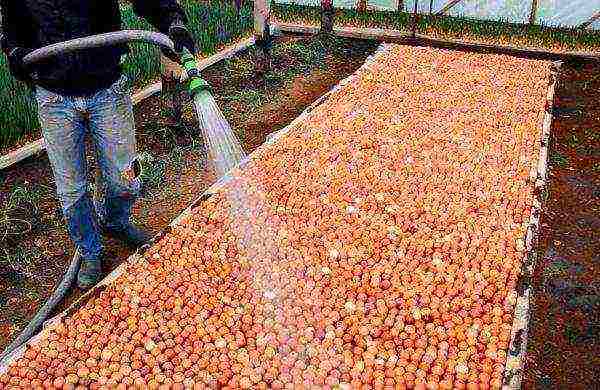 Bridge method of planting onion sets
Bridge method of planting onion sets
When it rises
When growing seedlings in open ground during spring planting, seedlings appear above the soil surface for 9-11 days... If the planting work was carried out in October, then the first greenery breaks through, depending on weather conditions, more often this occurs in early-mid April.
Greenhouse cultivation also guarantees different periods of emergence of seedlings, which is due to the variety of construction and the thermal conductivity of its surfaces. In the most ordinary polycarbonate greenhouse, you can see the greenery breaking through from the ground in late February and early March.
When using the bridge method of growing seedlings, you can get the first shoots 5-6 days after disembarkation.
How to care and loosen
For the growing season, it is important to saturate the soil with oxygen, remove weeds from the beds, water the seedlings and introduce groundbait.
After the emergence of seedlings above the surface of the soil, it is necessary loosen the soil every 2 weeks in the beds to prevent the formation of an earth crust.
 Loosening of the soil must be carried out every 2 weeks.
Loosening of the soil must be carried out every 2 weeks.
This process is often combined with weeding to remove weeds, which creates favorable conditions for disease and onion decay. In addition, such a neighborhood contributes to the formation of a thick neck, which subsequently complicates the drying of the crop.
Onions belong to crops that can do without baits, but this is the case when the soil is fertile. Many gardeners use a 2-3 time bait regime:
- 20-25 days after planting the seedlings, watering is carried out with a manure solution (1 kg per bucket of water);
- loose application of mineral fertilizers (urea, nitrophoska) before irrigation.
Watering of the beds is carried out with strict control of the degree of soil moisture... Lack of moisture is just as unacceptable as its abundance. If you carefully observe the plant, you can understand what the slightest changes indicate. The water should not be salty; if dirty, you need to drain a little from the bucket.
The appearance of a bluish-white tint on the leaves indicates insufficient watering, and the pallor of the feathers indicates an abundance of moisture. For the first couple of months, the seedlings are irrigated weekly (7-8 liters per 1 m2). Since July, the amount of water is reduced, and 3 weeks before harvest it stops altogether.
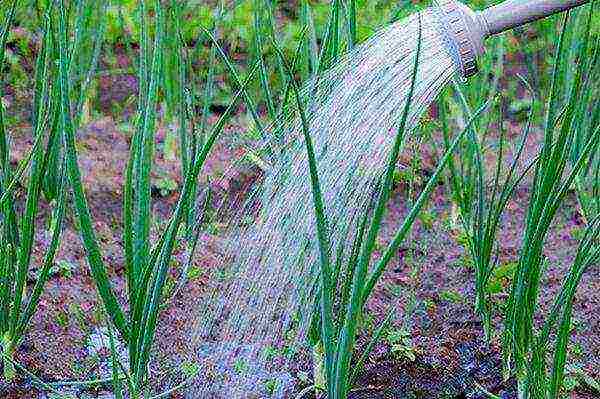 Strict control of soil moisture is extremely important
Strict control of soil moisture is extremely important
To protect against onion flies, it is recommended to use saline watering, which also stimulates plant growth.
200 grams of salt is taken per bucket of water, the amount of liquid is prepared at the rate of 300 ml per one bush. The procedure is repeated Once every 3 weeks... If the treatment proved to be ineffective, the concentration should be increased to 450 g / 10 l of water.
Is it afraid of frost and what temperature it can withstand
Onions are afraid of freezing and freezing temperatures at night. The temperature indicators of the air during planting should be within +12 degrees, soils at a depth of 10 cm - at least +5 degrees. Planting material germinates at 4-5 degrees... Mature onions of specially selected varieties can withstand frost down to -7 degrees, while sweet varieties die at -4 degrees.
When choosing a set, the climatic conditions of the region should be taken into account in order to give preference to the appropriate varieties.
Taking care of onions is quite simple if you perform the preparatory work correctly. Controlling the condition of the plant's feather will be a hint, and the action plan will not let you forget about important procedures that guarantee a high yield.
In the article, we discuss onions - growing a vegetable. We will tell you about the varieties of the plant and the diseases to which they are susceptible. You will learn when and how to plant onions in the ground, how to properly care for the plant. By following our advice, you will learn how to harvest and store it properly.
Onion varieties
 Onions are planted with seeds, seedlings and sets
Onions are planted with seeds, seedlings and sets
Onions are a popular vegetable crop all over the world. In Russia, the first varieties of onions appeared in the 12th century. Today there are over 400 varieties of this plant. Popular varieties: Stardust, Cupido, Odintsovsky, Hiberna, Rostovsky, Danilovsky, Stuttgarter Riesen, Carmen, Shetana, Centurion and Strigunovsky.
Onion varieties can be divided into two large groups - heat-loving and frost-resistant.In addition, there are early-, mid- and late-ripening onions. Early maturing turnips ripen within 90 days after planting, mid-maturing - after 110, and late-maturing - by 4 months.
Onion varieties differ in taste. There are sweet types of onions or salad, semi-sharp and spicy. The pungency of a plant depends on the content of essential oils in it - the higher it is, the sharper the onion.
Depending on the variety, onion husks and pulp have different shades. You can meet onions yellow, purple, white, sand, lilac and gray-white.
By the nature of growth, small, medium and multi-nested varieties are distinguished:
- small-breeding - during the growing season they give one, less often two bulbs in the nest;
- medium-sized - from 2 to 3 bulbs ripen;
- multi-nest - from 5 to 20 bulbs are formed in one nest.
You learned what types of onions exist and how they differ from each other. We will tell you how to grow onions in the open field.
Planting onions in open ground
Onions are planted in open ground with seeds, seedlings or sets - small onions... The most common way to grow onions is from onion sets.
Before planting, the seedlings are sorted out, dried and diseased bulbs are thrown away. To grow turnip onions from a set, it is preheated in the oven at a temperature of 40-45 degrees for 5 hours. The cooled planting material is disinfected in a 1% solution of potassium permanganate and dried.
When grown from seeds, they are soaked in warm water for 2-3 days. It is necessary to change the water daily to avoid stagnation. Then the seeds are laid out on damp gauze. After 2-3 days they sprout, you can start planting.
When to plant onions in the ground
 When planting seedlings, the first shoots will appear in 3-4 months.
When planting seedlings, the first shoots will appear in 3-4 months.
Growing onions from seedlings in the open field is carried out in early spring - at the end of March or at the beginning of April. As soon as the topsoil, up to 10 cm deep, warms up to a temperature of 10-12 degrees, they begin sowing seeds or planting seedlings. The optimum air temperature for disembarkation is not lower than 3-5 degrees.
When planting annual varieties with seeds, the first shoots appear on day 21. From nigella seeds, the bulb appears in 1 year, and it takes 3 to 4 months to grow onions for a turnip from seedlings.
Soil for onions
Onions prefer loamy, neutral soil with a pH of 6.4 to 6.7. Before planting, acidic soil should be flavored with slaked lime or dolomite flour. Do this 2-3 years before planting the onion.
In autumn, the soil is prepared for planting a plant. About 1 bucket of compost, 30 gr. Is added per 1 square meter. urea, 20 gr. potash fertilizers without chlorine and 25 gr. superphosphate granules. Before planting onions, add 10 grams to the soil. nitroammofoski per 1 square meter and dig it up.
Then you can plant onions
Onions develop better and give a high yield if planted after vegetables such as cabbage, carrots, zucchini, cucumbers, tomatoes, beets, radishes, potatoes. Onions take root well after melons and legumes.
How to plant onions outdoors
Sevki are planted in rows with a distance of 20 cm between them. The bulbs are placed in the holes at a distance of 4-6 cm from each other at a depth corresponding to the size of the seed so that the soil completely covers it, and the tail remains outside.
The seeds are sown in loose soil in grooves, 1-1.3 cm deep. A couple of centimeters are kept between the seeds and sprinkled with earth. After planting, the soil is flavored with humus and gently watered through a spray bottle.
Planting onions before winter
Planting material for growing onions for a turnip is divided into sets and wild oats. The sevok has dimensions from 1.5 to 3 cm in diameter. It is planted in spring, and before winter the smallest bulbs are planted - wild oats. The size of these onions is less than 1 cm.
In the southern regions, wild oat is planted in open ground, in the northern regions - in a greenhouse. When planting in open ground, the main thing is to be in time before the onset of stable frosts. Usually, onions are planted in late October or early November.
The wild oat is planted in grooves up to 5 cm deep at a distance of 15-20 cm between the rows. Sprinkle the onion with dry earth and press a little with your hand. 10 days after planting, the beds are watered.
Before the onset of frost, the planting is mulched with dry leaves, pine and spruce branches. From above, you can press with branches so that the foliage is not blown away by the wind. If winter is expected to be harsh, cover the bed with foil.
Onion care
Onion care consists in timely watering, feeding and pest control. When grown from seed, seedlings are thinned out, leaving a distance between plants of 2 cm.
To increase the yield, the beds are periodically weeded from the weeds. The soil is loosened after each watering at a depth of 2-3 cm. Before the first shoots, the soil is weeded between the rows, after - and around the bulb.
Watering
During the period of sowing seeds or planting seedlings, onions need a sufficient amount of moisture. At this time, it is watered every 4-5 days. A month after the first shoots, the number of watering is reduced to 1 time per week. In hot weather, watered every 7-9 days. In the rainy season, onions can do without additional moisture.
Top dressing
During the growing season, onions are fed 2-3 times. If the soil is fertile, then once a season is enough.
The first feeding is carried out when the leaves grow in height from 7 to 9 cm, the second and third - every 3 weeks. Mullein, superphosphate, bird droppings, potassium chloride and urea are used as top dressing.
Treatment
For the fertility of the onion, it is important not to start crops and regularly weed the beds. At the same time, the plant should not be hilled, otherwise the onion will grow frail and less juicy.
You learned about onion growing and outdoor care. Now let's talk about the pests and diseases that the plant is susceptible to.
Onion pests and diseases
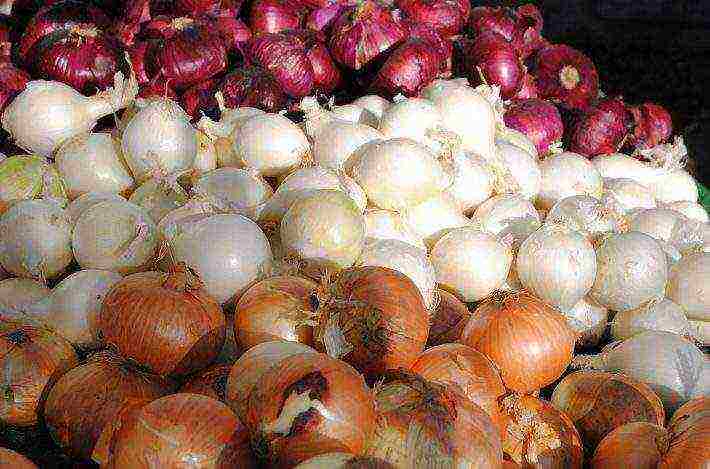 It is important to follow the rules for caring for onions, this will reduce the risk of contamination of the vegetable with diseases.
It is important to follow the rules for caring for onions, this will reduce the risk of contamination of the vegetable with diseases.
Onion crops are often attacked by insects. Most often crops are affected by onion flies. Their larvae eat up the pulp of the plant, after which the bulb rots and the feathers wither. When a pest is found, the plants are dug up.
Onion crops are parasitized by thrips, hidden proboscis, moths, nematodes. All these pests feed on onion feathers and lead to wilting of the plant. Regular loosening of the soil is an effective prevention against these insects.
Onions are susceptible to fungal diseases such as root rot and downy mildew. These diseases are manifested by changes in the color of the feathers - white spots and black dots appear on them. Onion leaves curl and wither.
To combat fungal diseases, the soil around the onion is sprayed with biofungicides and bioinsecticides. Onions planted for greens are not treated for insects. To fight pests with the help of pesticides is possible only when planting on bulbs.
Harvesting and storing onions
The ripeness of the onion is determined by the leaves of the plant. In fully ripe onions, they dry out en masse. After all the leaves have wilted, the bulbs are pulled out of the ground along with the roots.
The bulbs are cleaned of soil and laid out in a cool, ventilated place. Dry the turnips for 2-3 weeks, periodically turning them over. After drying, the roots are cut and the bulbs are sorted out.
Store onions at a temperature of 16 to 22 degrees in a ventilated place. Dampness and freezing temperatures will shorten the storage period.
You learned about the rules for growing onions in the open field and caring for the plant. Let's summarize.
For more information on how to plant onion sets, see the video:
What to remember
- There are over 400 varieties of onions.
- For planting onions, seeds, seedlings or sets are used - small onions.
- To increase the fertility of the onion, it is important not to start crops and regularly weed the beds.
- Onions are susceptible to fungal diseases, and they are often attacked by onion flies, thrips, lurkers, moths, and nematodes.
.
Onions are known for their beneficial and healing properties.This vegetable is included in national dishes, cuisines of all peoples of the world. Humanity had to study for many years the methods of planting and caring for this plant. Growing onions is a capricious activity that requires a lot of effort and knowledge. The information received from our ancestors allows us to use onions not only in cooking, but also in medicine. And the main advantage of growing this vegetable is considered to be planting not only in the open field, but also on the windowsill of your own home. It is most convenient to use onion sets for such conditions.
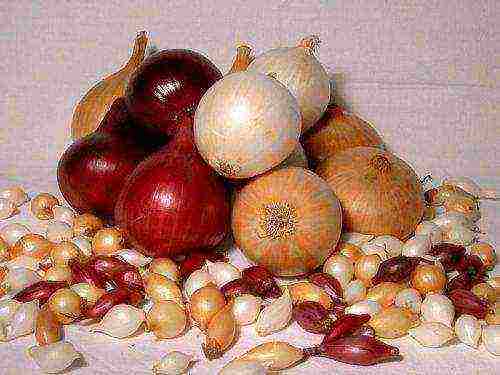
Onion sets of different varieties
Description of varieties
Onion sets are a planting material, not a variety. Such a vegetable is small in size, 1.5–2.5 cm in diameter. Such parameters are due to one-year development.

Sevok and Stardust bulbs are one of the most delicious
Onion seeds are planted in the spring, and already in the autumn, small fruits are harvested. For the winter, the onion sets are transferred indoors, and in the spring the seedlings are planted in open ground or in a pot on the windowsill. Depending on climatic conditions, such operations can be performed for 2 years. In colder regions, the planting of onion sets is often postponed a year in advance so that the fruit reaches the desired size. Having planted such seedlings in the spring, you can be content with ripe onions already for the winter. By the time it is harvested, a large vegetable can already be stored for a long time, at a suitable temperature for this. The timing of its cultivation may vary due to influencing external factors. This method is popular with residents of moderate climates. Planting and maintenance methods may differ, precisely because of the difference in temperature indicators and the type of soil.

Popular onion varieties
In addition to these characteristics, onion cultivation is influenced by the variety of its varieties. It depends on the choice of a person whether the grown vegetable will be tasty and large.
The volume of the harvest also depends on the selected variety. Correctly performed care will give the maximum effect both in terms of the quality of vegetables and their quantity. Choosing the necessary variety of onion sets for your needs and requirements, you can vary the timing of planting and collecting material, as well as use some secrets for caring for it. It is not difficult to buy seedlings or seeds. Planting material has a large number of varieties suitable for different growing methods.
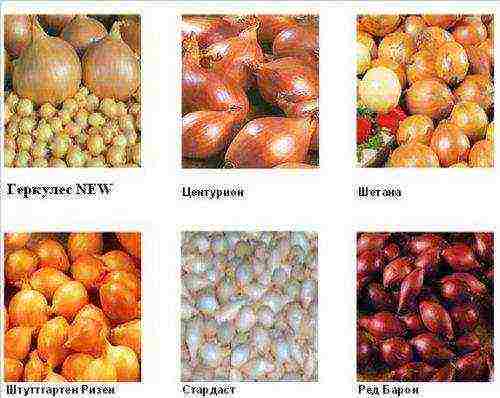
The best new varieties of onions
The most popular are: Bessonovsky, Strigunovsky, Timiryazevsky, Zolotnyachek, etc.
Each of the varieties has its own nuances: planting time, suitability for growing under a certain soil, type of fertilizer, and frequency of watering.
Variety Bessonovsky
The Bessonovsky variety is one of the most ancient. His birth took place in Penza. Possesses a lot of positive qualities. Onion sets of this variety ripen quickly, are stored for a long time and are easily transported. Diseases are rarely disturbed by the variety. It can be planted both in temperate climates and colder ones. The shape of the fruit is round. White colour. Each bulb weighs 50-70 grams. On one nest, there can be up to 5 such units.

Bessonovsky onion
Strigunovsky variety
The Strigunov variety is fast growing. Ripening period - 1 year. White bulbs, weighing 45–80 grams, lie well in winter. There are 2-3 fruits on one bush. The "Timiryazevsky" variety also possesses such qualities. Their main difference is the color of the scales. For Timiryazevsky it has a brown tint, while for Strigunovsky it is yellow.
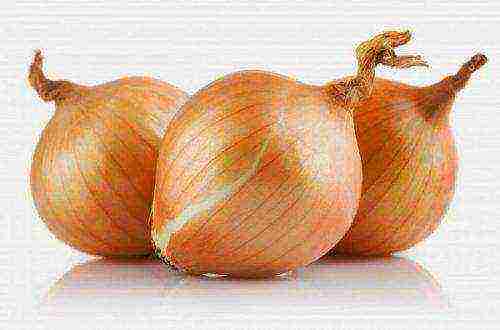
Strigunovsky onion - an old proven variety
Variety "Zolotnichok"
Variety "Zolotnichok" also ripens quickly, goes to the feather and lies well in the winter. Its name is fully characterized by the appearance of the plant. The scales have a golden hue. Having chosen the suitable seedlings, according to your preferences or climatic conditions, you can think about how to grow onion sets.
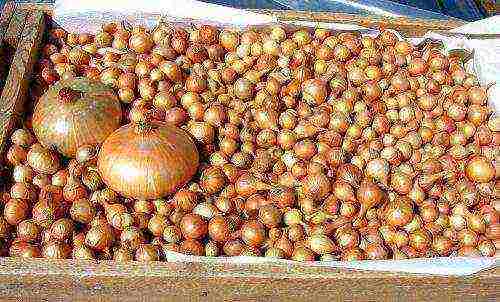
Variety Zolotnichok - bulbs and sets
The scheme and methods for this can be different. Before planting a vegetable, you must familiarize yourself with all the nuances of care.
Preparatory activities
Planting onion sets in the spring requires timing. Dates and exact numbers are out of the question here. Onions must be planted when the soil is warmed up by solar energy to a depth of 10-15 cm. If we draw the ratio to the month, then for some conditions it is April, for others - May. It is necessary to plant a vegetable only in a heated soil. This factor is the first and most important when growing a crop.
At a soil temperature of 12-14 degrees, you can dig in seedlings or sow seeds. Earlier in time, in a colder land - this cannot be done.
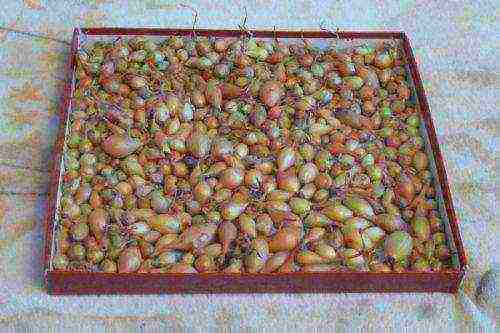
Warming up the seed makes it harder and increases the yield.
The preparation of the planting material is equally important. Onion sets require heating. There is a whole scheme of such events. Correctly performed warming up, allows you to get the highest growth rates and crop yields. The preparation of the onion takes place step by step:
- The planting material is scattered on a flat surface and left to stand for 2-3 weeks. Temperature - 18-20C.
- The onions are heated for 7-10 hours. The manipulation temperature is 38–40C. It is important to avoid overexposure.
- Disinfection and stimulation of the growth of planting material is carried out.
- The growth of onion sets is stimulated by special mineral fertilizers. Before processing onions as such, they are washed with warm and cold water alternately.
- The bulbs are immersed in the solution as a whole for 5-7 hours. After carrying out such measures, disinfection is carried out. This can be done with potassium permanganate or copper sulfate solution.
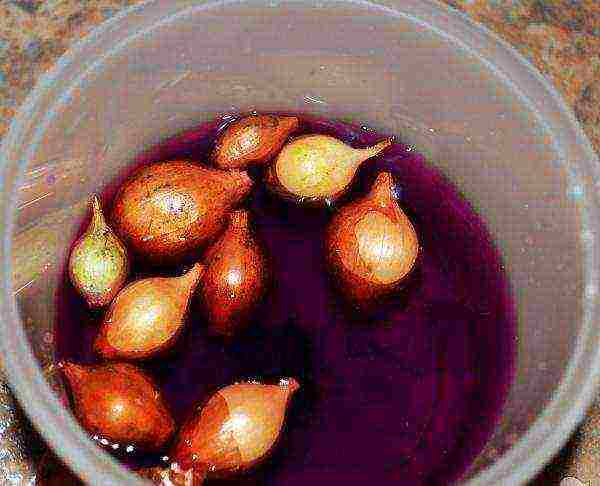
Potassium permanganate treatment - disease prevention
There is also a popular method of preparing onions before planting. This requires:
- Dry the onions for one week. The air temperature must be at least 20C.
- Rinse the planting material in a saline solution. The bulbs are placed whole in it and lie for 2-3 hours.
- Rinse the onion with running water.
- Disinfect with potassium permanganate, placing the material in it for 2 hours.
- Rinse again.
- Dry the scales until dry.
Correctly performed preparatory measures allow you to end up with high-quality planting material, from which the largest and healthiest harvest will be obtained. Only after carrying out such manipulations, you can plant onion sets.
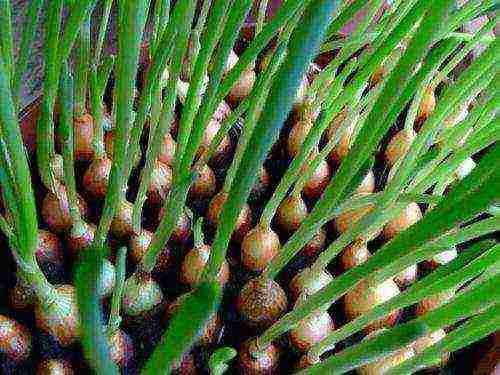
Forcing onion sets on a feather
Planting bulbs
The first step in planting onions is choosing a suitable location. The soil on which they plan to place the beds should be as illuminated as possible by sunlight. The ideal place is land with deep groundwater deposits. Although onion sets are a moisture-loving vegetable, they do not like excessive watering. With an excess of moisture, it quickly dies.

Ash is introduced into the prepared beds
The preparation of the landing site is carried out in the winter. Before the onset of frost, the soil is dug up to a depth of 16-20 cm and fertilized into it. Manure or peat compost is best. Fertilizer is applied only before cold weather, before planting this should not be done. It is necessary to pay attention to the acidity of the soil.
Onions do not grow in an acidic environment, therefore, they often add to the ground: lime, chalk, wood ash, etc. You cannot add fertilizer and lime at the same time.
This combination reduces the efficiency of soil fertility, nitrogen is removed from manure and peat - an element important for the growth of onions.
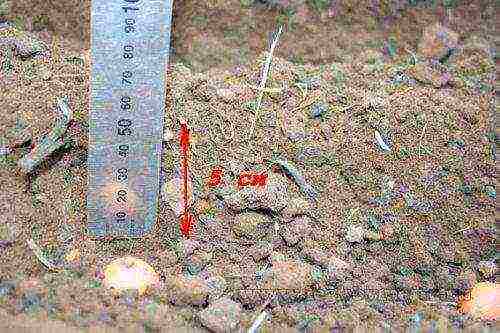
Planting depth of onions
Seedlings are planted in the spring. But before that, in 1 week the soil is dug up and watered. Watering with water and vitriol solution serves as an easy form of fertilizer. This method is optional. You can do without it. Vitriol is also replaced with other types of fertilizers. But you should be careful. Excessive exposure to chemicals on the bulbs can kill it or reduce growth performance.
Before planting, the bulbs are sorted by size in order to mark the distance between the beds and the material:
- bulbs with a diameter of 1 cm, planted 5 cm apart;
- bulbs 1.5 cm - 8 cm;
- up to 2 cm
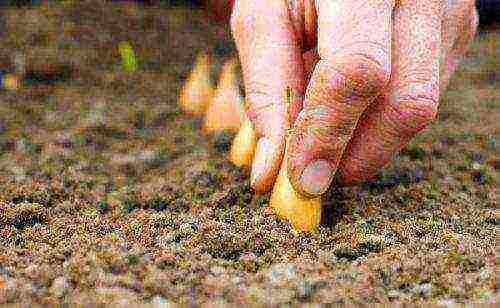
Sevka planting is done in rows
–10 cm.
The beds should be made no more than 25 cm apart so that the root system develops better. It is this distance that more concentrated absorbs moisture in the root system of plants. Watering the bulbs will be easier and easier. The planting material is dug into the ground by 4-5 cm.
The tops of the bulbs are sprinkled with mulch. Sawdust or straw is best. Layer thickness - 3-4 cm.
Bulb care
Planting and caring for onions is not easy. Good watering, fertilization and any other care will not bring results if there are pests. Once the onion has sprouted, it becomes vulnerable to insects - onion flies. If a feather turns yellow on green sprouts, this is a sign of illness. Pests eat onions unnoticed by humans. When his feather turns yellow, the seedlings can no longer be considered fit for human consumption. There are many ways to protect onions from insects, but they all work if the plant is still healthy, not damaged.
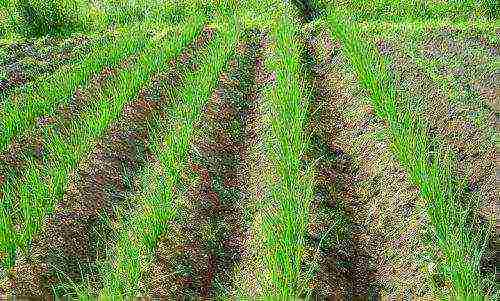
Onion rows should be at least 30 cm apart
It is possible to properly protect the onion from flies and from the disease that kills it with the help of: special preparations, tobacco ash or a solution of potassium permanganate.
Most of the methods are considered prophylactic. When the bow has not yet been shot, it has a strong odor. It is he who attracts insects. Pests, with properly used protective equipment, do not smell this smell and will bypass the plant.
Peculiarities
Moderate watering is an important factor. When the onion has sprouted, care for it becomes thorough. A month after planting, watering is reduced from 1 time per week to every 12-14 days. It is important to monitor the looseness of the soil. Its fluffing allows to saturate the plant root system with oxygen. If this is not done, diseases may appear. The feather turns yellow, watering becomes less effective and routine care already performs negative functions.

Ready-made onion fertilizers guarantee a full harvest
There is a lot of information on how to plant onion sets. Often, diseases in a healthy plant appear for no apparent reason. If pests and diseases do not attack the onion, and the feather turns yellow and dies, it is important to check for the presence of pest plants in the neighboring beds. It is in these that the danger lurks. These are garlic and carrots for onions.
Diseases of the plant are not terrible when there are cucumbers, cabbage and tomatoes nearby. The smell of some of these even repels harmful insects.
With timely feeding of onions, diseases are not terrible for the plant. The feather turns yellow only by autumn. The plant is protected by two stages of fertilization. To do this, use manure or special mixtures, which are poured onto the garden bed before watering.

Harvest of onion sets - Radar variety
Onions are dug out for the winter. The vegetable is stored for a long time in a dry, dark and cool place. The onion is able to lie like this all winter until warm days. Some varieties can be planted multiple times. Therefore, the remnants of onion stocks are sent back to the beds in the spring in order to get a good harvest for the next winter, digging it up in the middle of autumn.
Subscribe Be aware of new products on our site
Onions in our climate are grown in a two-year turnover. In the first year, seeds are sown on the beds, the so-called "nigella", from which small onions - sevok - grow by the fall. Sevok is kept warm in winter, and in spring they are planted again in the beds, getting from it by autumn large marketable bulbs suitable for food and winter storage.
Planting onions
Planting onion sets begins with the selection of a site for sowing seeds. When choosing a site, you need to consider that it should be:
- fertile;
- clean of weeds.
And this is not a whim. The root system of onions is small, weak and covers a small volume of soil - hence the requirements for soil fertility. Onion seeds germinate very slowly (two to three weeks), and the emerging seedlings grow at a snail's pace for a month.At this time, the weeds actively grow and strongly oppress the young onion sprouts.
It is very useful to bring humus, phosphorus and potassium granules to the area allocated for the cultivation of seedlings in the fall for digging. Fresh manure, even in autumn, cannot be applied under nigella; it enhances the nitrogen nutrition of plants in the second half of cultivation, and thereby stimulates the growth of leaves to the detriment of bulb ripening.
Onions are among the plants that are very demanding on the temperature and moisture of the soil. It gives a generous harvest only on humus-rich soils that hold moisture well. The most suitable for it are light sandy loam chernozems and silted floodplain areas.
Phosphorus fertilizers are needed throughout the season: in young plants, they promote root growth, and in adults, they accelerate the ripening of the bulbs. Potash fertilizers are needed in the middle of the growing season - they contribute to the formation of bulbs and increase resistance to diseases.
Ideal precursors for onions: cucumbers, tomatoes, early cabbage and other early harvest crops. Before digging a site, humus is added per square meter at the rate of 5 kilograms, superphosphate and potassium chloride: 30 and 15 grams. After that, the bed is dug onto the bayonet of a shovel and immediately harrow the surface with a rake to close the moisture.
To get good onion sets, planting in spring should begin as early as possible, especially since the plant is cold-resistant and is not afraid of spring frosts. But planting should not be done before the soil becomes physically ripe and stops sticking to the tool.
After waiting for this time, the beds dug up in the fall must be loosened with a rake and immediately after that, the seeds must be sown. This usually happens already at the end of April, and in the southern regions at the end of March.
Nigella is sown with multi-line tape. For sowing, grooves are laid with a depth of 2 centimeters, a distance of about ten centimeters is left between the lines. It is desirable to moisten the grooves. In total, up to 10 grooves are laid in the tape.
With this planting scheme, seed consumption should be a maximum of 8 grams per square meter. m. Seeds are planted no deeper than 2 cm. After sowing, it is advisable to mulch with humus with a layer of 5-10 millimeters.
Growing onions
When shoots appear for the first time, they weed and at the same time loosen the soil. Weeds are pulled out very carefully, by hand or with the help of a small hand tool - a hoe or a ripper.
In the first half of the growing season, it is necessary to create conditions for the growth of leaves. To achieve this goal, watering, loosening and weeding are important. Loosening should be done frequently, to a depth of 5 centimeters.
We must not forget about protecting plants from a dangerous pest - onion flies. The emergence of onion flies is usually observed at the time when dandelions are blooming. By this time, you need to have time to use one of the preventive measures: sprinkle the soil with tobacco, equally mixed with fluff, or ground naphthalene mixed with sand 1:20, you can simply spray the leaves with karbofos.
In the second period of growth of onion sets, weed control comes to the fore. Watering is stopped in July. If, in the second period, you continue to apply fertilizing and watering, this will delay the ripening of the onions.
Common varieties of onion sets
- Timiryazevsky - two-year-old, fast-ripening, spicy, there are few bulbs in the nest. The sevok turns out to be round-flat, hard, dense. The upper scales are light brown, the inner ones are white.
- Strigunovsky is a two-year-old, fast-ripening variety, sharp, fruitful. Sevok is round, small, but dense and lying. Dry scales are light yellowish, inside the bulb is white.
- Bessonovsky is an old variety of unknown selection, two-year-old, early ripening, pungent taste, fruitful, well kept, transportable. The bulbs are flat, running down to the neck. Dry scales are yellow and yellowish with a lilac tint, inside the onion is white.
- Oktyabrsky - mid-season, semi-acute, well kept.
The description of onion sets is not limited to these varieties. Each region has its own varieties and zoned varieties, with high yields, adapted to local climatic conditions. Novice gardeners need to start with them.
It is important to remove the onion sets in time, its cultivation ends when the leaves fall en masse. This usually occurs in early August. After that, the seedlings are dug up and dried until the leaves are completely dry, then the dry remains of the leaves are cut off.
Dry sets can be stored. Private gardeners can store sets in the winter in a room at 18-22 degrees. To do this, it is folded into nylon and hung in a dry place.
About a kilogram of seedlings are dug from a meter of the sown area, but in favorable conditions it is possible to get a more plentiful harvest. In the spring, the seedlings are sorted into small, medium and large, at the same time removing the bulbs that have completely dried up during the winter.
Onion care
The soil for planting turnip onions is prepared in the same way as when growing seedlings. In the spring, pre-planting loosening of the beds is carried out by 10 centimeters, after which they must be immediately hardened. These operations are carried out just before landing. By this time, the topsoil should warm up to at least 6 degrees. It is advisable to warm the seedlings at a temperature of 45 degrees for 24 hours before planting to protect against infection.
Sevok is planted as follows.
- Make grooves with a chopper, leaving 20 centimeters between them.
- Granular superphosphate is introduced into the grooves - 10 g / m2.
- The bulbs are planted at a distance of 8-12 centimeters from each other.
- The planted bulbs are covered with soil in such a way that a layer of soil is one and a half to two centimeters above them.
- Bulbs of the same size are planted on one bed, since the ripening period and growth rate of turnip onions depend on the size of the seed. Loosening and weeding begins only when the leaves reach a height of 10 centimeters. Why so late? This is to keep the bulbs from injury.
If the garden bed is well prepared for onion sets, growing and caring for it cannot be called a burdensome business. It all comes down to just a few top dressing and loosening. As for protection, the turnip is protected from onion fly larvae in the same way as the sets.
After the onion grows 10-12 centimeters, you can draw a groove with a hoe angle between the rows and make the first top dressing using any organic or inorganic nitrogen fertilizer in liquid form. After fertilization, the furrows must be leveled.
3 weeks after nitrogen fertilization, a second liquid fertilization with potassium chloride is made. Potash fertilization stimulates intensive bulb formation. At the same time, onions require the greatest amount of moisture.
In order to easily remove the onion sets, the care of the soil and plants is completed a month before digging. The soil should be dry by this time, so watering of the onions is stopped in July. Dry soil contributes to good maturation. Mass lodging of leaves serves as a sign of harvesting ripeness.
The onions are dug up, and, if the weather is dry, they are left to dry right in the garden until the leaves are completely dry. If the weather is inclement, then drying is carried out under the roof. It is desirable that the room temperature is 25-35 degrees.
Onions are kept indoors for 10 days. It is advisable to raise the temperature to 45 degrees in the last 12 hours of drying. This will kill spores of downy mildew and cervical rot, diseases that spoil the bulbs during storage.
The sun's rays are a good prophylaxis against storage diseases. To do this, digging is done in sunny weather and the crop is dried in the sun.
After drying, the leaves are cut off on the bulbs, leaving a stump 3 centimeters long. The turnip, laid for winter storage, must be well-ripened, healthy in appearance, without mechanical damage.The yield of turnip onions per square meter is two or more kilograms, and with good agricultural technology - up to four kilograms.


